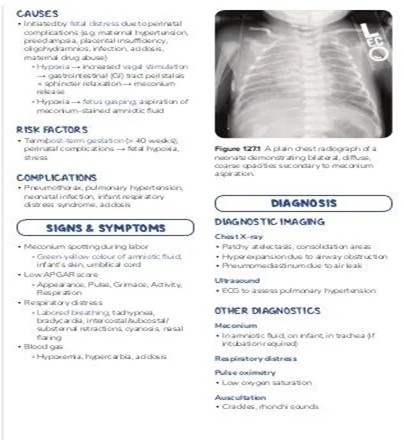The nursery nurse attends the delivery of a post-term infant. Upon initial assessment, the infant is lethargic, has coarse breath sounds and blood gases indicate acidosis. An X-ray shows a honeycomb appearance. These signs are consistent with which complication of the newborn?
Meconium Aspiration Syndrome
Respiratory Distress Syndrome
Bronchopulmonary Dysplasia
Transient tachypnea of the Newborn
The Correct Answer is A
The signs described are consistent with Meconium Aspiration Syndrome (MAS). Meconium aspiration occurs when the fetus has a bowel movement before or during delivery and inhales meconium-stained amniotic fluid into the lungs. This can lead to airway obstruction, chemical pneumonia, and respiratory distress, which may progress to respiratory failure, persistent pulmonary hypertension, and death. The presence of coarse breath sounds, acidosis, and the honeycomb appearance on X-ray are all signs of MAS.

Nursing Test Bank
Naxlex Comprehensive Predictor Exams
Related Questions
Correct Answer is D
Explanation
Perineal hematoma is a complication that can occur after vaginal births, typically due to trauma or injury to the perineum during delivery. Wound dehiscence, UTIs, and DVTs are all possible complications associated with cesarean births. Wound dehiscence is a separation of the layers of the surgical incision, UTIs can occur due to catheterization during the surgery, and DVTs can occur due to immobility during the recovery period.
Correct Answer is C
Explanation
Betamethasone is a corticosteroid that enhances fetal lung maturity, which can help reduce the risk of respiratory distress syndrome and other complications in preterm infants. It does not reduce maternal and fetal tachycardia associated with terbutaline administration, suppress uterine contractions, or maintain maternal respiratory effort and ventilation during magnesium sulfate therapy.
Whether you are a student looking to ace your exams or a practicing nurse seeking to enhance your expertise , our nursing education contents will empower you with the confidence and competence to make a difference in the lives of patients and become a respected leader in the healthcare field.
Visit Naxlex, invest in your future and unlock endless possibilities with our unparalleled nursing education contents today
Report Wrong Answer on the Current Question
Do you disagree with the answer? If yes, what is your expected answer? Explain.
Kindly be descriptive with the issue you are facing.
